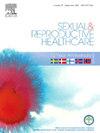约旦妇女子宫切除术后抑郁症的患病率和预测因素:一项多中心横断面研究
IF 1.7
3区 医学
Q3 PUBLIC, ENVIRONMENTAL & OCCUPATIONAL HEALTH
引用次数: 0
摘要
目的本研究旨在评估接受子宫切除术的约旦妇女中抑郁症的患病率,并确定其人口统计学特征和社会支持水平之间的关系。方法本研究包括在约旦首都安曼的政府医院接受子宫切除术治疗的18岁以上妇女。研究工具为人口统计问卷、抑郁与压力量表(DASS)和社会支持量表。DASS将抑郁程度分为“无抑郁”、“轻度”、“中度”、“重度”和“极度严重”。结果该研究包括220名参与研究的女性;其中68.2% (n = 150)已婚,平均年龄48.17岁(SD = 11.78)。大约一半的女性报告称经历了某种形式的抑郁症状。研究发现,抑郁与年龄之间存在显著的负相关关系(r = - 0.403;p & lt;0.001),儿童数(r =−0.342;p & lt;0.001),性模式改变。此外,抑郁与婚龄、体重指数、就业状况、婚姻状况、生育意愿、受教育程度、家庭收入有显著正相关。与抑郁相关的整个回归模型显著,R2为0.256。接受子宫切除术的约旦妇女的抑郁与年龄有显著关系(β = - 0.315, p <;0.001);性别变化(β = - 0.207, p = 0.001);儿童数(β = - 0.202, p = 0.002)。结论:抑郁症在约旦接受子宫切除术的妇女中非常普遍,并且与年龄、性别变化和子女数量有显著关系。本文章由计算机程序翻译,如有差异,请以英文原文为准。
Prevalence and predictors of depression in Jordanian women post-hysterectomy: A multi-centre cross-sectional study
Purpose
This study aimed to assess the prevalence of depression among Jordanian women who underwent hysterectomy and determine the associations with their demographic characteristics and their social support levels.
Methods
The study included women over 18 years who underwent hysterectomy and received care at government hospitals in Amman, the capital of Jordan. The study instruments were a demographic questionnaire, a Depression, and Stress Scale (DASS), and a social support scale. The DASS categorises depression levels as ’No depression’, ‘Mild’, ’Moderate’, ’Severe’, to ’Extremely severe’.
Results
The study included 220 participating women; 68.2 % of them (n = 150) were married, with a mean age of 48.17 (SD = 11.78) years. Approximately half of the women reported experiencing some form of depressive symptoms. The study found significant negative relationships between depression and age, (r = −0.403; p < 0.001), number of children (r = −0.342; p < 0.001), and sexuality pattern change. Additionally, there were significant positive correlations between depression and duration of marriage, body mass index, employment status, marital status, fertility wishes, education level, and family income. The whole regression model concerning depression was significant, with an R2 of 0.256. Depression among Jordanian women who underwent hysterectomy was significantly predicted by their age (β = −0.315, p < 0.001); sexuality change (β = −0.207, p = 0.001); and number of children (β = −0.202, p = 0.002).
Conclusions
Depression was highly prevalent among Jordanian women who underwent hysterectomy and was significantly predicted by age, sexuality change, and number of children.
求助全文
通过发布文献求助,成功后即可免费获取论文全文。
去求助
来源期刊

Sexual & Reproductive Healthcare
PUBLIC, ENVIRONMENTAL & OCCUPATIONAL HEALTH-
CiteScore
2.70
自引率
5.60%
发文量
73
审稿时长
45 days
 求助内容:
求助内容: 应助结果提醒方式:
应助结果提醒方式:


